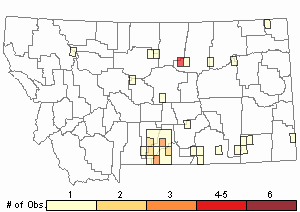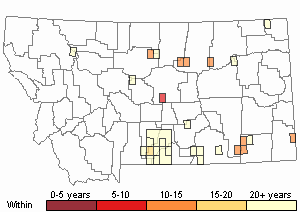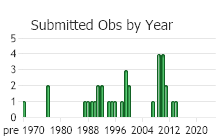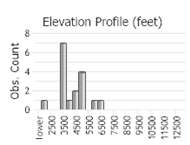View in other NatureServe Network Field Guides
NatureServe
Montana
Utah
Wyoming
Idaho
Wisconsin
British Columbia
South Carolina
Yukon
California
New York
Woodland Agrimony - Agrimonia striata
State Rank Reason (see State Rank above)
Agrimonia striata is known from many locations in the north-central to northeast and in the southwest portions of Montana. It usually associates with riparian areas, moist meadows, and moist drainages in areas with or without manmade disturbances; however, threats to populations or viability have not been documented. It appears to be stable, though more current data on population locations, sizes, and threats are needed.
- Details on Status Ranking and Review
Range Extent
ScoreF - 20,000-200,000 sq km (~8,000-80,000 sq mi)
Area of Occupancy
ScoreE - 26-125 4-km2 grid cells
Number of Populations
ScoreC - 21 - 80
Number of Occurrences or Percent Area with Good Viability / Ecological Integrity
ScoreC - Few (4-12) occurrences with excellent or good viability or ecological integrity
Environmental Specificity
ScoreC - Moderate. Generalist or community with some key requirements scarce
Threats
ScoreD - Low
General Description
PLANTS: Agrimonia striata is a perennial herb with erect stems, growing 40 to 80 centimeters tall (Lesica et al. 2012; Kline and Sorenson 2008). At least on the upper portions, the stems have stiff hairs as well as softer pubescence and glandular hairs (Kline and Sorenson 2008).
LEAVES: There are 5 to 13 leaflets (excluding much smaller “minor” leaflets, which are present in 1 to 4 pairs between each set of large leaflets). The large leaflets are 1 to 6 centimeters long, show acuminate tips, and have various types of pubescence underneath, like the upper stems (Lesica et al. 2012; Kline and Sorenson 2008). The non-glandular types of pubescence are most prominent along the veins (Kline and Sorenson 2008). Stipules are egg-shaped or sickle-shaped and 5 to 20 millimeters long (Lesica et al. 2012; Kline and Sorenson 2008).
INFLORESCENCE: There are up to 60 flowers arranged subopposite along a 5 to 20 centimeter long raceme (Kline and Sorenson 2008; Lesica et al. 2012).
Phenology
Blooms from late June to early August (Kline and Sorenson 2008). Before plants go dormant in the fall they grow a structure resembling a basal rosette. It actually is a short stem with a small cluster of leaves on internodes that are only a few millimeters apart. The next year, this section grows into the flower-bearing stem (Kline and Sorenson 2008).
Diagnostic Characteristics
Distinguishing the types of pubescence (use a hand lens) and their distribution on the plant is essential for identifying Agrimonia species (Kline and Sorenson 2008). There are four types of hairs: short-stalked glandular; sessile, glistening glandular; non-glandular soft (either straight or wavy); and non-glandular stiff and straight (hirsute). On its upper stem, A. striata has both types of glandular hairs and both soft and hirsute non-glandular hairs. A. gryposepala has both types of glandular hairs and but only hirsute non-glandular hairs (Kline and Sorenson 2008).
Mature fruits provide a useful distinction: in A. striata, the lowest row of hypanthium bristles projects at a 90 degree angle, whereas in A. gryposepala the lowest bristles project below horizontal (Kline and Sorenson 2008). Leaflets often have acuminate tips in A. striata, while the tips are rarely acuminate in A. gryposepala (Kline and Sorenson 2008).
Species Range
Montana Range
Range Descriptions

 Native
Native
Range Comments
BC to NL south to AZ, NM, IA and NY (Lesica et al. 2012. Manual of Montana Vascular Plants. BRIT Press. Fort Worth, TX).
Observations in Montana Natural Heritage Program Database
Number of Observations: 41
(Click on the following maps and charts to see full sized version)
Map Help and Descriptions
Relative Density

Recency



 (Observations spanning multiple months or years are excluded from time charts)
(Observations spanning multiple months or years are excluded from time charts)
Habitat
Ecology
The fungal parasites Pucciniastrum agrimoniae and Sphaerotheca macularis are known to infect Agrimonia striata (Thurston and Kern 1931; Mix 1954). A gall fly, Contarinia agrimoniae (Diptera: Cecidomyiidae) has been found as larvae on A. striata flowers, as well as on blackberry (Rubus sp.) flowers (Stiles et al. 1996).
A. striata is apparently somewhat frost-tolerant: observations after the first frost of fall showed no damage to the leaves, though cultivated corn and squash were completely killed (Stevens 1924).
Reproductive Characteristics
Flowers: Five short (1 to 2 millimeter) sepals rise above the grooved hypanthium, which surrounds the five longer (3 to 5 millimeter), light yellow petals (Lesica et al. 2012). There are 10 to 15 stamens (Lesica et al. 2012).
Fruit: As it matures, the hypanthium expands to 4 to 6 millimeters in length and develops 3 or 4 rows of hardened bristles; the lowest row points outward at a 90 degree angle (Kline and Sorenson 2008). It surrounds a single globe-shaped achene, which is 2 to 3 millimeters across (Lesica et al. 2012).
Management
Plants of the genus Agrimonia contain tannins and have been used medicinally to tighten tissues (astringent), to stimulate the liver (cholagogue), to aid digestion (stomachic), and to reduce inflammation (antiphlogistic) (Cernaj and Oravec 1993). Some preparations of A. striata have antibacterial properties (Carlson et al. 1948).
Stewardship Responsibility
References
- Literature Cited AboveLegend:
 View Online Publication
View Online Publication Carlson, H.J., H.G. Douglas, and J. Robertson. 1948. Antibacterial substances separated from plants. J. Bacteriol. 55(2):241-248.
Carlson, H.J., H.G. Douglas, and J. Robertson. 1948. Antibacterial substances separated from plants. J. Bacteriol. 55(2):241-248. Cernaj, P. and V. Oravec. 1993. Variability of active substances in Agrimonia L. species. Acta Horticulturae 330:133-136.
Cernaj, P. and V. Oravec. 1993. Variability of active substances in Agrimonia L. species. Acta Horticulturae 330:133-136. Kline, G. J. and P. D. Sorenson. 2008. A revision of Agrimonia (Rosaceae) in North and Central America. Brittonia 60(1): 11-33.
Kline, G. J. and P. D. Sorenson. 2008. A revision of Agrimonia (Rosaceae) in North and Central America. Brittonia 60(1): 11-33. Lesica, P., M.T. Lavin, and P.F. Stickney. 2012. Manual of Montana Vascular Plants. Fort Worth, TX: BRIT Press. viii + 771 p.
Lesica, P., M.T. Lavin, and P.F. Stickney. 2012. Manual of Montana Vascular Plants. Fort Worth, TX: BRIT Press. viii + 771 p. Mix, A.J. 1954. Report of the 1952 foray. Mycologia 46(1):112-123.
Mix, A.J. 1954. Report of the 1952 foray. Mycologia 46(1):112-123. Stevens, O.A. 1924. Some effects of the first fall freeze. The American Midland Naturalist 9(1):14-17.
Stevens, O.A. 1924. Some effects of the first fall freeze. The American Midland Naturalist 9(1):14-17. Stiles, H.D., P.J. Semtner, and T.D. Reed. 1996. Discovery of Contarinia agrimoniae (Diptera: Cecidomyiidae) Larvae in Damaged Blackberry (Rubus subgenus Eubatus spp.) Flower Buds. J. Entomol. Sci. 31(1):138-141.
Stiles, H.D., P.J. Semtner, and T.D. Reed. 1996. Discovery of Contarinia agrimoniae (Diptera: Cecidomyiidae) Larvae in Damaged Blackberry (Rubus subgenus Eubatus spp.) Flower Buds. J. Entomol. Sci. 31(1):138-141. Thurston, Jr., H.W. and F.D. Kern. 1931. Notes on some rust collections from Colorado, Wyoming, and South Dakota. Mycologia 23(1):77-82.
Thurston, Jr., H.W. and F.D. Kern. 1931. Notes on some rust collections from Colorado, Wyoming, and South Dakota. Mycologia 23(1):77-82.
- Additional ReferencesLegend:
 View Online Publication
View Online Publication
Do you know of a citation we're missing? DuBois, K.L. 1979. An inventory of the avifauna in the Long Pines of Southeastern Montana. M.Sc. Thesis. Bozeman, MT: Montana State University. 113 p.
DuBois, K.L. 1979. An inventory of the avifauna in the Long Pines of Southeastern Montana. M.Sc. Thesis. Bozeman, MT: Montana State University. 113 p. Eggers, M.J.S. 2005. Riparian vegetation of the Montana Yellowstone and cattle grazing impacts thereon. M.Sc. Thesis. Montana State University, Bozeman, MT. 125 p.
Eggers, M.J.S. 2005. Riparian vegetation of the Montana Yellowstone and cattle grazing impacts thereon. M.Sc. Thesis. Montana State University, Bozeman, MT. 125 p. Lesica, P., M.T. Lavin, and P.F. Stickney. 2022. Manual of Montana Vascular Plants, Second Edition. Fort Worth, TX: BRIT Press. viii + 779 p.
Lesica, P., M.T. Lavin, and P.F. Stickney. 2022. Manual of Montana Vascular Plants, Second Edition. Fort Worth, TX: BRIT Press. viii + 779 p. Tuinstra, K. E. 1967. Vegetation of the floodplains and first terraces of Rock Creek near Red Lodge, Montana. Ph.D dissertation. Montana State University, Bozeman 110 pp.
Tuinstra, K. E. 1967. Vegetation of the floodplains and first terraces of Rock Creek near Red Lodge, Montana. Ph.D dissertation. Montana State University, Bozeman 110 pp.
- Web Search Engines for Articles on "Woodland Agrimony"





